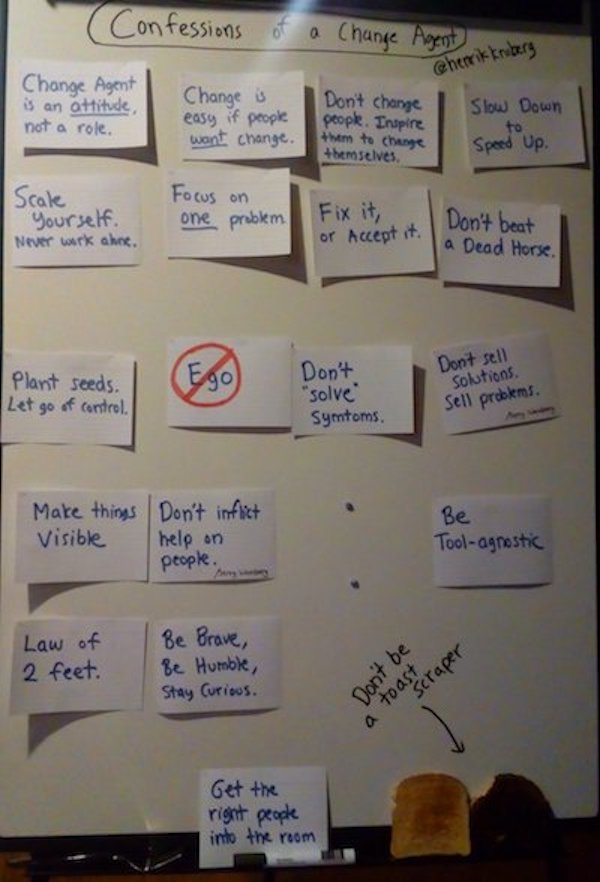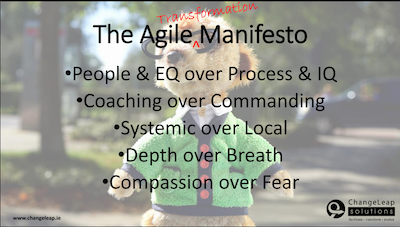I recently attended the awesome Agile Lean Ireland 2018 conference in Croke Park Dublin. Three of the talks in particular really stuck with me - the opening keynote and two in the afternoon, and I’d like to share my takeaways from them.
Opening keynote - Confessions of a change agent (Henrik Kniberg)
When I saw who was delivering the opening keynote of this conference, I knew I just couldn’t miss it! Henrik Kniberg has long been an inspiration for me, and I knew I needed to hear his insights from his experience as a change agent! I was not disappointed: his talk was enlightening, entertaining, and anyone who chooses flipcharts over slidedecks will always get a thumbs up from me.
Henrik got the crowd laughing from the beginning, when he introduced his friend Mike (or mic, the microphone). Mike suffers from schizophrenia, often changing his accent, his job role and even his gender! Of course, in reality the microphone was simply being passed around the audience, but the way in which it was introduced got us all laughing.
Henrik went through various confessions of a change agent - he gave 18 insights into what it means to be in such a role, one of which really stuck with me:
“As a Change Agent you can’t make change happen, but you can create an environment that increases the odds.”
This is a powerful reminder of what it means to lead a transformation - I’ve seen many businesses hire an Agile Coach or Consultant and expect miracles, when our focus isn’t on forcing change but enabling it! You can lead a horse to water, but you can’t make it drink.

I’ve had a few people who were following my live tweeting ask me what on earth was with the toast?! With some suggesting Henrik has lost his marbles, and others wondering if it was a reference to Deming’s famous quote “Let’s make toast American style - you burn, I’ll scrape.” Yes, Henrik really did have a physical toaster on stage, but really it’s not as crazy as it sounds. As hilarious as it was to watch him eat burnt toast, he was making a very valid point. Imagine working with someone whose job is simply to make toast, but who keeps burning it. One potential solution would be to hire a team of testers, who would scrape the toast before shipping it - but in this case, not only would the organisation still produce burnt toast, you’d also have a whole load of testers to pay as well - i.e. you’re treating the symptom without actually solving the problem. This metaphor reminds change agents as well as organisations as a whole to really think about what the problem is instead of diving straight in with knee-jerk solutions to it. Maybe the right solution is simply to turn down the timer on the toaster, which has the added bonus of reducing the time taken to get the toast to the end customer. Hello lead time reduction!
Henrik ended his presentation with three brief but powerful statements - “Be brave. Be humble. Stay curious.” All of these are important, but for me the second one struck a chord. I’ve met so many people in different professions who lose their humility as they move up the ranks or collect certificates from multiple 2 day training courses. For me, this statement is a reminder that we are all on different paths, but we should never look down upon others or forget where our journey began.
Disrupt your Agile Transformation (Gail Park)
Gail Park from ChangeLeap Solutions delivered an excellent talk that brought us back to the crux of Agile transformations. Be clear what is driving the organisation to change by asking 2 core questions:
- Why are you changing?
- What are you trying to fix?
The answer to these questions should guide what approach to take. For example, some organisations might be changing just to follow the trend - they’ve heard of agile, their competitors might be using it, and they want a piece of the action. Or there might be more to it, which can be found out with the second question. Perhaps the organisation has identified that there’s poor customer engagement and so they want to try agile to bridge the gap between the business and its end users, by involving them throughout the entire business lifecycle with more frequent feedback loops.
Gail then gave some insights into how to succeed with an Agile Transformation, by bringing in at least one neutral Agile Coach. Regardless of whether the coach(es) belong to the organisation or are external consultants, their neutral mindset is key to transitioning to Agile.
In addition to Agile Coaches, Gail also suggested the creation of a Lean Change Management Group made up of various people from across business areas within the business. The group provides support to the Agile Coach and essentially act as agile advocates, helping spread the agile message and practices as well as providing extra energy to the the teams and assisting communication.
I came away with three key points from Gail’s talk:
- If you’re serious, don’t try it alone. Without additional coaches or a change group to spread the message across the organisation it will be difficult to truly transition to Agile in all business areas.
- Prepare. Get help. The organisation needs to do some prep work by understanding what they’re trying to fix and why they’re changing - once they have answered these questions the Agile Coach(es) will have a clearer direction of what help they can provide and where in the organisation it is needed first.
- Agile transformations are people centric, not process centric. A reminder that change can trigger emotional responses, and Agile Coaches need to be prepared for this by helping the change to happen - rather than just commanding people what to do.

Is the Toyota way any way to run things in 2018? (Dee Morrissey)
I’ve been a fan of Dee Morrissey for a while, and was getting a bit worried when I noticed her name badge was still sat on the table at lunch time. I needn’t have worried. Dee opened her talk requesting that the audience keep an open mind - she’d just come from delivering a PRINCE2 course and doesn’t believe that agile and waterfall are mutually exclusive. Music to my own ears!
Dee spoke about how Lean was and still is more than Toyota and the Toyota Production System. Her talk then took the direction of Digital Disruption which focuses on value to create new ways to carry out business. She took the 14 principles from the Toyota Way, and reinterpreted them for 2018. For example:
- Base your management decisions on a long-term philosophy, even at the expense of short-term financial goals - reinterpreted to - Enterprise Architecture
- Create a continuous process flow to bring problems to the surface - reinterpreted to - UX
- Use “pull” systems to avoid overproduction - reinterpreted to - Technology nullifies the requirement
The key takeaway from Dee’s talk is that people and businesses rely on technology as an enabler to disrupt traditional markets. Lean is more than a method and a lot of the principles from the Toyota Way should be interpreted differently in 2018 to how they were in 2001.
To the pub!
After a long day of information-overload, I was happy to retreat to one of Dublin’s hundreds of famous pubs to mull over everything I’d heard about over a cold beer.
I kept coming back to two recurring themes I’d noticed throughout the day:
- Culture: This word kept getting bounced about, with nearly every talk I attended saying something in relation to culture. It got me thinking - what do we actually mean by the word culture? Is it to do with where we come from? The behaviours and beliefs of an organisation? Or has it simply become a buzzword, in the same vein as Agile with a capital A? It’s definitely given me food for thought, and I encourage you to challenge yourself and others when you use the word “culture” to try to explain what that means to the person who said the word in the specific context.
- Value Stream Mapping: This divided the crowd almost as much as #noEstimates has divided the community since 2012. Some conference attendees were real advocates for the power of VSM, whereas others found it boring and a real waste of time. Nevertheless, the consensus in both camps is that visualising your workflow is incredibly important, as is useful metrics. Dee’s answer to another attendees question “which metric do I start with if I’m not currently collecting any?” was to start with where you are now, think about what you’re trying to find out and start small. This goes along with my thinking - don’t start collecting every metric you’ve heard name dropped just because other people are. Identify what you want to know, find a way to measure that and remember to analyse the results and most importantly to make change. You can always add additional metrics later, so go at a pace that is right for your environment and stop trying to copy what everyone else is doing!
Agile Lean Ireland was a great conference in a historic setting and enabled me to extend my stay in Ireland to catch up with friends and family. I’m already excited for next year’s event!